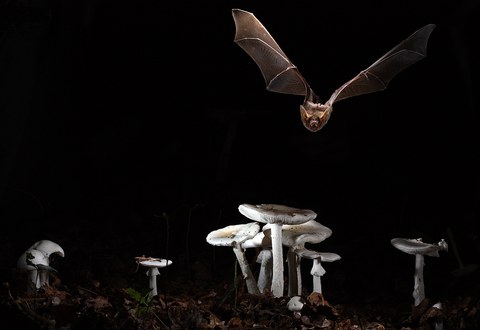Jul 29, 2020
The genetic basis of bats’ superpowers revealed
For the first time, the raw genetic material that codes for bats’ unique adaptations and superpowers such as the ability to fly, to use sound to move effortlessly in complete darkness, to survive and tolerate deadly diseases, to resist ageing and cancer - has been fully revealed and published in Nature.
Bat1K (bat1K.com), a global consortium of scientists dedicated to sequencing the genomes of every one of the 1421 living bat species, has generated and analyzed six highly accurate bat genomes that are ten times more complete than any bat genome published to date, in order to uncover bats’ unique traits.
“Given these exquisite bat genomes, we can now better understand how bats tolerate viruses, slow down ageing, and have evolved flight and echolocation. These genomes are the tools needed to identify the genetic solutions evolved in bats that ultimately could be harnessed to alleviate human ageing and disease,” Emma Teeling, University College Dublin, Co-Founding Director of Bat1K and Senior Author.
To generate these exquisite bat genomes, the team used the newest technologies of the DRESDEN-concept Genome Center (DcGC) – a shared technology resource in Dresden, Germany, to sequence the bat’s DNA, and generated new methods to assemble these pieces into the correct order and to identify the genes present. The DcGC is run by experts from the TU Dresden and its Center for Regenerative Therapies Dresden (CRTD), the Max Planck Institute of Molecular Cell Biology and Genetics (MPI-CBG), as well as the Center for Systems Biology Dresden (CSBD).
“Using the latest DNA sequencing technologies and new computing methods for such data, we have 96-99% of each bat genome in chromosome level reconstructions - an unprecedented quality akin to for example the current human genome reference which is the result of over a decade of intensive "finishing" efforts. As such, these bat genomes provide a superb foundation for experimentation and evolutionary studies of bats’ fascinating abilities and physiological properties” Eugene Myers, Director of Max Planck Institute of Molecular Cell Biology and Genetics, and the Center for Systems Biology, Dresden, Germany, Senior Author.
The team compared these bat genomes against 42 other mammals to address the unresolved question of where bats are located within the mammalian tree of life. Using novel phylogenetic methods and comprehensive molecular data sets, the team found the strongest support for bats being most closely related to a group called Ferreuungulata that consists of carnivores (which includes dogs, cats and seals, among other species), pangolins, whales and ungulates (hooved mammals).
To uncover genomic changes that contribute to the unique adaptations found in bats, the team systematically searched for gene differences between bats and other mammals, identifying regions of the genome that have evolved differently in bats and the loss and gain of genes that may drive bats’ unique traits.
“Our genome scans revealed changes in hearing genes that may contribute to echolocation, which bats use to hunt and navigate in complete darkness. Furthermore, we found expansions of anti-viral genes, unique selection on immune genes, and loss of genes involved in inflammation in bats. These changes may contribute to bats’ exceptional immunity and points to their tolerance of coronaviruses.” Michael Hiller, Max Planck Research Group Leader, Max Planck Institute of Molecular Cell Biology and Genetics in Dresden, Max Planck Institute for the Physics of Complex Systems, and the Center for Systems Biology, Dresden, Senior Author.

